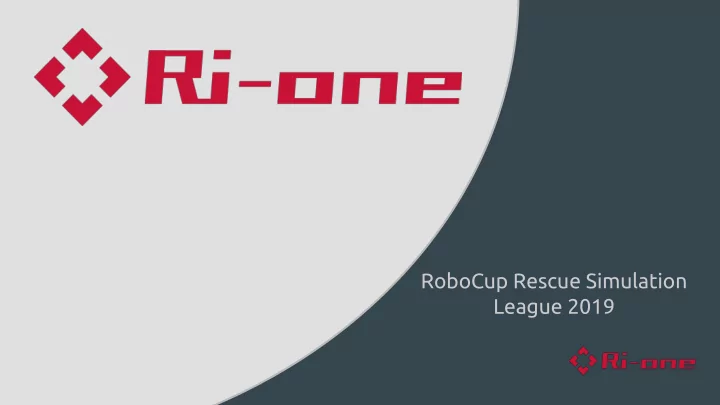

RoboCup Rescue Simulation League 2019
Introduction ● Last year: ● This year: ○ K-means++ Algorithm ○ fixed Team Detector(AT) ○ Team Detector(AT) ○ Beforehand ○ Dynamic Clustering(FB) Extinguish(FB) ○ New Priority System(PF) ○ Solve Congestion(PF)
Algorithm - K-means++ algorithm (2018) - A* Algorithm (2017) Clustering & Path Planning
K-means++ Algorithm (2018) K-means disadvantage ● Improper points can be chosen ○ The solution can be worse. ○ K-means unsuited to clustering in a biased map. K-means++ algorithm solved these problems. ● K-means++ is conscious of below points. ○ Initial centers were chosen spreadly.
K-means++ Algorithm (2018) K-means K-means++ The clustering work adequately.
A* Algorithm (2017) A* Actual Cost Heuristic The distance of Distance of goal parent node
A* Algorithm (2017) Left? Right?
A* Algorithm (2017) A* Actual Cost Heuristic The distance of Distance of goal parent node + Clear repair cost
A* Algorithm (2017) Left Right
A* Algorithm (2017) A* Actual Cost Heuristic The distance of Distance of goal parent node + 1 / Clear repair cost
A* Algorithm (2017) Left Right
Communication - Same as Sample.
Search - Same as Sample.
AT was implemented : Ambulance Team - Efficient assignment for victims according to condition of AT and time. fixed Team Detector
Team Detector (2018) We analyzed strategies of other teams to improve to make a better score. Table. The results of analysis of VC3’s log data of the top 4 in RoboCup2017 Team Rate of rescued civilian Rate of rescue action Rate of cooperation Aura 10% 20% 23% MRL 22% 17% 22% RoboAKUT 13% 18% 21% SEU-UniRobot 9% 22% 19% Other team built groups of AT dynamically and reduced time to rescue civilians.
Team Detector (2018) : civilians : AT ● AT set victim as a candidate for allocation in order of highest priority. ● Selected AT : existing in the circle centering on a victim in order of closeness.
Team Detector (2018) : civilians : AT 2 1 4 2 4 4
Team Detector (2018) : civilians : AT 2 1 4 2 4 4
Team Detector (2018) : civilians : AT 2 4 2 4 4
Team Detector (2018) : civilians : AT 4(>2) 2 4 4
Team Detector (2018) : civilians : AT
Team Detector (2019) Last year ● It was not considered what criterion would form the AT group. This year ● As the cycle progressed and the fire spread, the radius increase. In the end, the area is doubled in the final step.
Team Detector (2019)
FB was implemented : - extinguish the fire near the gas station in priority. Fire brigade - beforehand extinguishing the buildings that were not deal with gas station burning and adjacent to the & burning building. Beforehand Extinguish
Problems of our team’s FB ● The number of FBs was limited ● Fire occurred at multiple locations ● The situation of the disaster was changing by every moment → needed appropriate action of FB according to the situation of the fire.
Problems of our team’s FB It is difficult to suppress the fire spread once. → need extinguish as soon as possible.
Beforehand extinguish ● If four FBs are assigned the same target and extinguish it, a FB do beforehand extinguishing. ● The FB who is the farthest from the target extinguish the highest temperature building near the burning building .
Beforehand Extinguish Building Building The highest The highest Burning Burning temp. Build. temp. Build. ● It’s decentralized decision ● using only distance and temperature
FB1(the farthest) FB2 Burning FB3 the highest temp. FB4
Deal with gas station
Deal with gas station ● Ignition of gas stations can cause massive explosions and cause serious damage not only to surrounding buildings but also to agents and civilians. ● FBs extinguish buildings near to gas stations as priority.
PF was implemented : Police Forces - A method of removing blockades on roads near a refuge in priority. Refuge Clear System & Solve Congestion
Hurdles and mission of PF ● The number of PFs was limited ● Needs quick rescue other agents and civilians with blockades. ● Necessary to secure paths to Refuge. → Prioritize the road to the refuges and rescue the agents and civilians.
Refuge Clear System ● Blockades on roads near refuges could prevent agents and civilians from reaching refuges and prevent FBs supplying water. ● PFs add roads with blockades and near refuges to the target list, and give priority to clear blockades on those roads.
Solve Congestion ● Blockades on roads which many agents and civilians passed cause congestion. ● Caught agent with blockade couldn’t move and take actions. ● PFs add roads where has many agents and civilians to the target list, and give priority to clear blockades on those roads.
Result
Result map Team kobe berlin sakae Ri-one 2019 136.19 70.56 12.31 Ri-one 2018 84.06 83.63 14.55 ● berlin and sakae have ○ too many victims in building compare with AT ○ too many fire buildings compare with FB at the start of simulation.
Thank you for listening
Recommend
More recommend